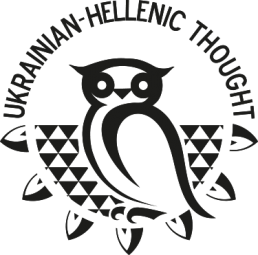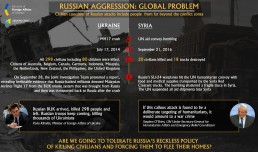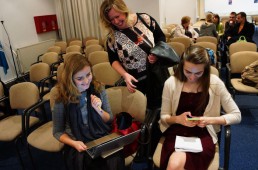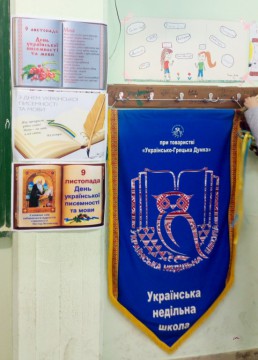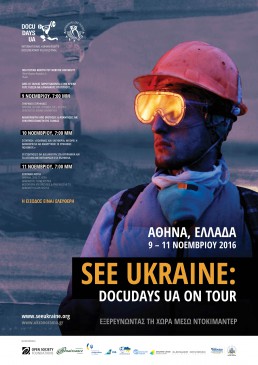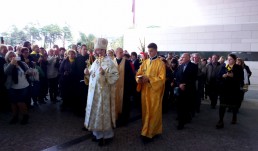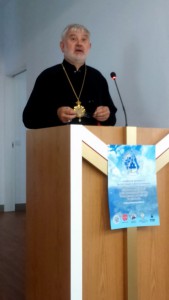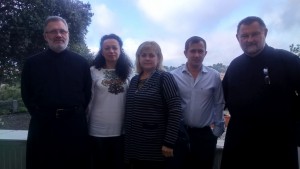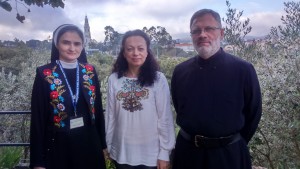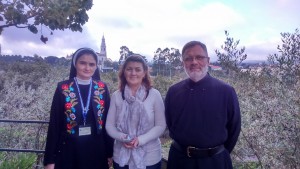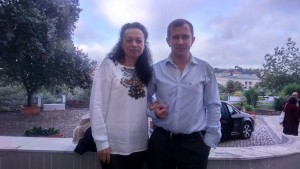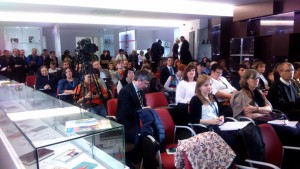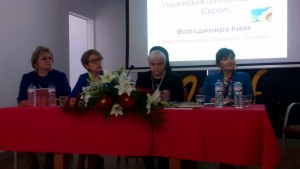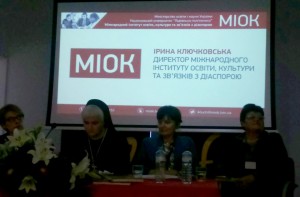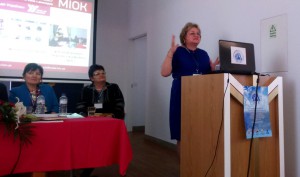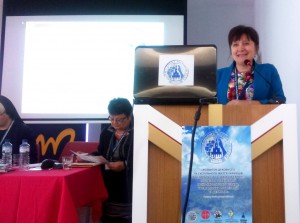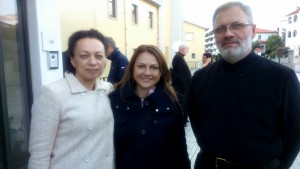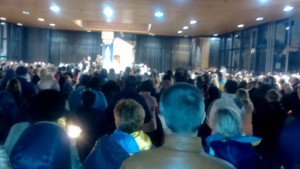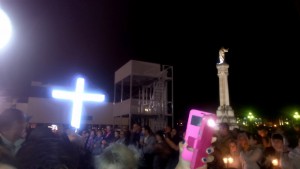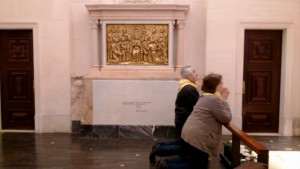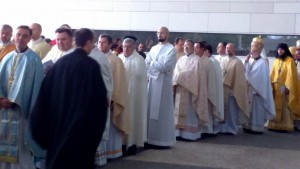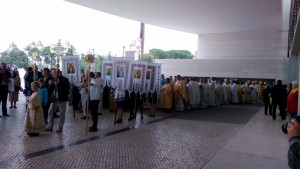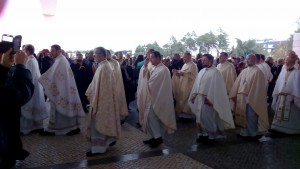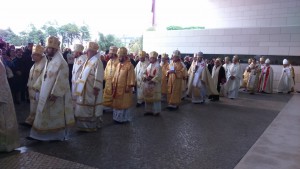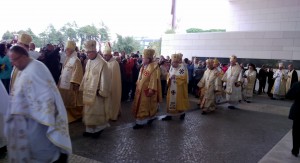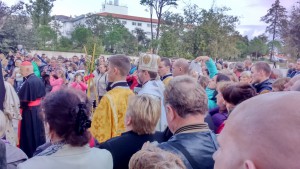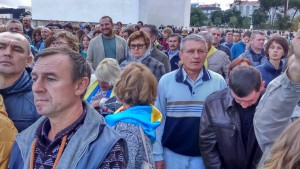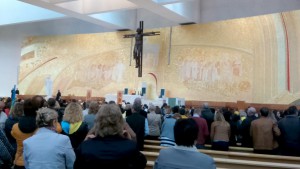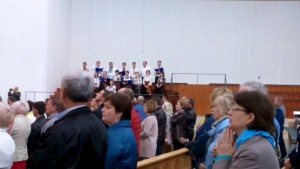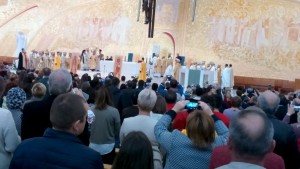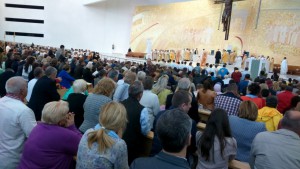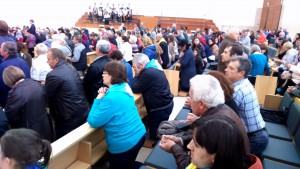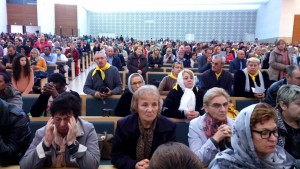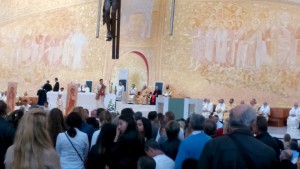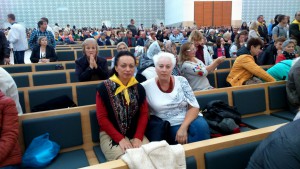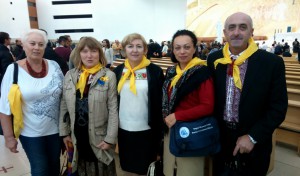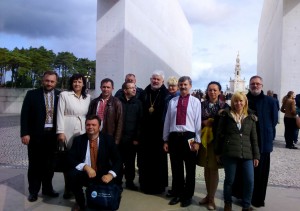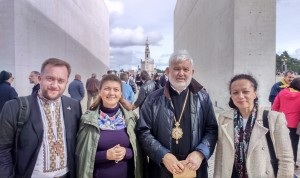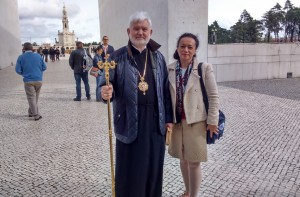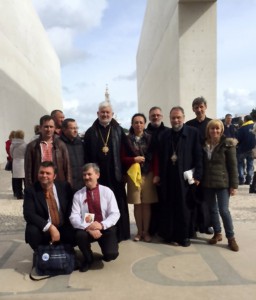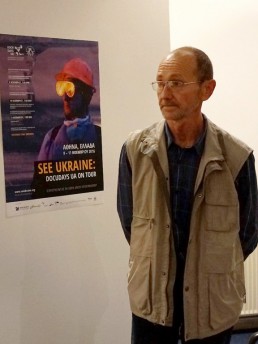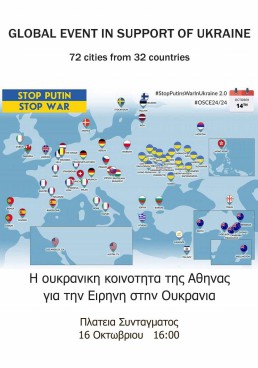Росія у Сирії
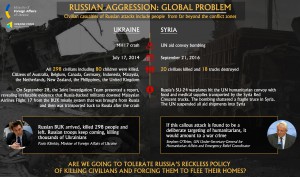 Російська агресія: глобальна проблема
Російська агресія: глобальна проблема
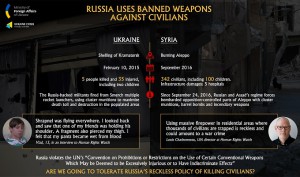 Росія використовує заборонену зброю проти мирного населення
Росія використовує заборонену зброю проти мирного населення
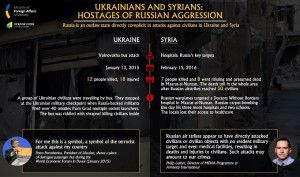 Українці та сирійці: заручники російської агресії
Українці та сирійці: заручники російської агресії
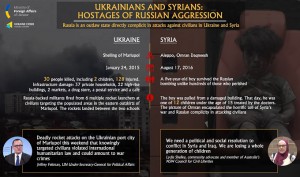 Українці та сирійці: заручники російської агресії
Українці та сирійці: заручники російської агресії
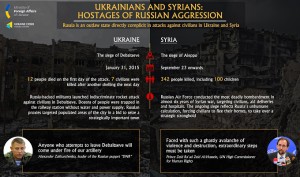 Українці та сирійці: заручники російської агресії
Українці та сирійці: заручники російської агресії
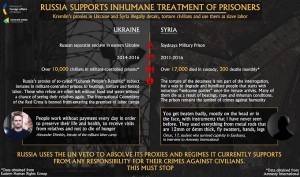 Росія підтримує негуманне ставлення до в’язнів
Росія підтримує негуманне ставлення до в’язнів
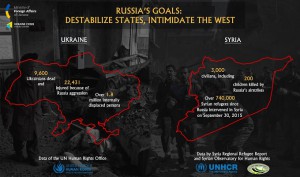 Мета Росії: дестабілізувати країни, залякати захід
Мета Росії: дестабілізувати країни, залякати західSee Ukraine in Athens. Restarting
The second part of “See Ukraine: Docudays UA On Tour” took place on 20 - 11 November in Athens. The festival was suspended in May because of the protest meeting organized by pro-Russian forces calling themselves “Greek atifascists”. On the eve of the opening on May 13th the managers of the Exile Room, the main festival venue in Greece, refused to host the festival events after radical groups’ call for a protest rally near the location. The festival was urgently relocated to the Embassy of Ukraine in Greece.

The participants of the discussion: Inga Korotkevych (translator), Nick Fragkakis (journalist), Halyna Masliuk (moderator), Oleksandra Matviychuk (human rights activist), Maryna Shkurova (translator)
The fetival team supported by Association of the Ukrainian Diaspora in Greece “Ukrainian - Hellenic Thought” has been loking for safe location for several months. The festival was finally organized at the culture center of Webster University in Athens. The program included films “Ukrainian sheriffs” by Roman Bondarchuk and “The Living Fire” by Ostap Kostiuk. After the screenings viewers were able to discuss films with heroes and authors. Discussion “Is democracy in war time possible?” by Ukrainian human rights activist Oleksandra Matviychuk and Greek journalist Nick Fragkakis also took place.

Project coordinators in Athens (Anna Maniati, Lesya Nedelcheva, Halyna Masliuk) and human rights activist Oleksandra Matviychuk
“For me the most interesting part of See Ukraine project journeys are discussions after films and speeches of experts on public discussions. For example, in Athens after “Ukrainian sheriffs” by Roman Bondarchuk people mostly discussed how documentary films that show problematic sides of life in the country actualize the work on these problems. Strong reaction was caused by the discussion ““Is democracy in war time possible?” The audience were arguing, whether it is more important for Ukraine to build the nation or civic society that will respect human rights regardless of language, skin color, religion, sexual orientation or gender. I believe it is for such discussions that we should oganize projects like this” - shares her impressions Yulia Serdyukova, “See Ukraine: Docudays UA On Tour” project coordinator. Photo: Yulia Serdyukova http://docudays.org.ua/eng/2016/news/kino/seeukraine-athens/Проект See Ukraine в Афінах. Перезапуск

9 – 11 листопада в Афінах відбулася друга частина проекту «Побачити Україну: Docudays UA мандрує світом» (See Ukraine). Нагадаємо, що у травні фестиваль був призупинений через мітинг, організований проросійськими силами, які назвали себе «грецькими антифашистами». 13 травня, у ніч перед відкриттям, менеджери Exile Room, головної фестивальної локації в Греції, відмовилися проводити фестиваль на своїй території, злякавшись заклику радикальних угрупувань зібратися на акцію протесту під стінами закладу. В екстреному порядку фестиваль був перенесений на територію Посольства України в Греції.

Учасники дискусії «Чи можлива демократія в часи війни?»: Інга Короткевич (перекладачка), Нік Фрагкакіс (журналіст), Галина Маслюк (модераторка), Олександра Матвійчук (правозахисниця), Марина Шкурова (перекладачка)
Кілька місяців команда фестивалю за підтримки Асоціації української діаспори «Українсько-грецька думка» шукала безпечну локацію в Афінах. Зрештою, фестиваль був організований на території культурного центру Webster University. До програми ввійшли «Українські шерифи» Романа Бондарчука та «Жива ватра» Остапа Костюка. Після показів глядачі мали змогу обговорити фільми з героями та авторами стрічок. Окрім того, відбулася дискусія «Чи можлива демократія в часи війни?» за участі української правозахисниці Олександри Матвійчук та грецького журналіста Ніка Фрагкакіса.

Грецькі співорганізаторки See Ukraine (Анна Маньяті, Леся Нєдєльчева, Галина Маслюк) та правозахисниця Олександра Матвійчук
«Під час подорожей у рамках проекту See Ukraine мені завжди найцікавіше спостерігати за дискусіями після фільмів та виступами експерток і експертів на публічних обговореннях. В Афінах, наприклад, після показу «Українських шерифів» Романа Бондарчука найбільше обговорювали те, як документальні фільми, що показують проблемні сторони життя в країні, актуалізують роботу над вирішенням цих проблем. Бурхливу реакцію з боку аудиторії також викликала дискусія «Чи можлива демократія в часи війни?». Слухачки й слухачі сперечалися про те, що більше потрібно Україні зараз – розбудова нації чи побудова громадянського суспільства, у якому дотримуються прав людини незалежно від мови, кольору шкіри, національності, релігії, ґендерної приналежності чи сексуальної орієнтації. Вірю в те, що заради таких дискусій і потрібно організовувати подібні проекти», – ділиться враженнями Юлія Сердюкова, координаторка проекту «Побачити Україну: Docudays UA мандрує світом».
Фото: Юлія Сердюкова
День Української писемності в "Українсько-Грецькій Думці"
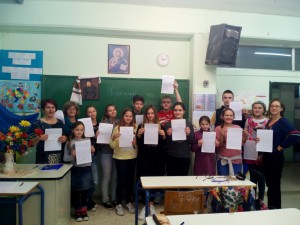 Всеукраїнський диктант національної єдності під заголовком "Україна на зламі тисячоліть" писали в суботу 12-го листопада старшокласники Української суботньої школи при Товаристві "Українсько-Грецька Думка", випробовуючи свої знання в українській мові поруч з українськими дітьми в Україні, які написали цей диктант 9-го листопада, коли в нашій країні відзначається День української писемності та мови.
Повільно, з гарною дикцією, диктувала текст диктанту директорка школи, вчителька мови та літератури Ганна Павлюк, допомагаючи в невидимий спосіб уникнути помилок чи краще зрозуміти, де "просяться" розділові знаки.
Старалися всі!
Разом із дітьми зосереджено старалися виводити каліграфічні букви вчителі школи Леся Куриляк та Олена Печак, а також голова товариства Галина Маслюк.
Мабуть, не секрет, кого найбільше хвилювали "нищівні" результати! :)
Хто не боїться, нехай спробує сам! :)
Всеукраїнський диктант національної єдності під заголовком "Україна на зламі тисячоліть" писали в суботу 12-го листопада старшокласники Української суботньої школи при Товаристві "Українсько-Грецька Думка", випробовуючи свої знання в українській мові поруч з українськими дітьми в Україні, які написали цей диктант 9-го листопада, коли в нашій країні відзначається День української писемності та мови.
Повільно, з гарною дикцією, диктувала текст диктанту директорка школи, вчителька мови та літератури Ганна Павлюк, допомагаючи в невидимий спосіб уникнути помилок чи краще зрозуміти, де "просяться" розділові знаки.
Старалися всі!
Разом із дітьми зосереджено старалися виводити каліграфічні букви вчителі школи Леся Куриляк та Олена Печак, а також голова товариства Галина Маслюк.
Мабуть, не секрет, кого найбільше хвилювали "нищівні" результати! :)
Хто не боїться, нехай спробує сам! :)
Галина МАСЛЮК. Світлини автора.
Україна на зламі тисячоліть За легендою, апостол Андрій Первозваний на одному з пагорбів, де нині Андріївська церква, напророчив: “На горах цих возсіяє благодать Божа, буде город великий і воздвигне Бог багато церков”. Передбачення збулося: на високому дніпровському березі народився золотоверхий Київ. Минали роки – слава про Київську Русь гриміла на весь світ, адже на зламі першого тисячоліття тут бурхливо розвивалися торгівля, право, освіта, культура. Королівським дворам Європи було за честь поріднитися з володарями Києва. Промовистим є такий факт: Анна, високоосвічена дочка Ярослава Мудрого, ставши королевою Франції, підписувала державні акти своїм ім’ям, тоді як її чоловік, король Генрик Перший, ставив усього-на-всього хрестик. Наша історія славна ще й звитяжними боями: упродовж століть відчайдушні козаки захищали Україну й усю Європу від дикої орди. Прикро, що на зламі другого тисячоліття нам, українцям, ціною життя найкращих синів доводиться боронити від східних сусідів свій європейський вибір. Сьогодні ми по-особливому розуміємо Шевченкову настанову любити Україну “во врем’я люте” і знаємо, що вистоїмо, бо за нами правда й славна історія. https://www.youtube.com/watch?v=2frCowPFoFc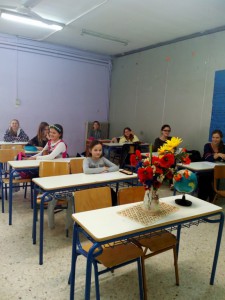
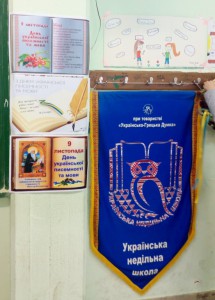
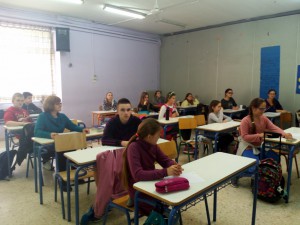
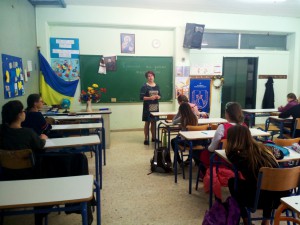
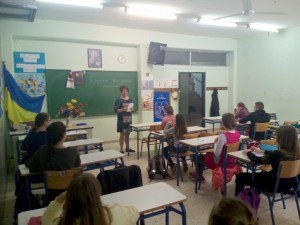
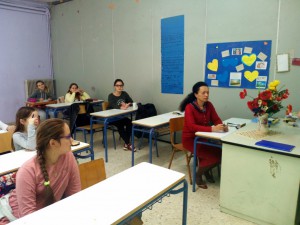

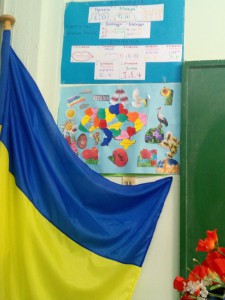

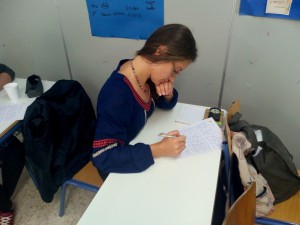
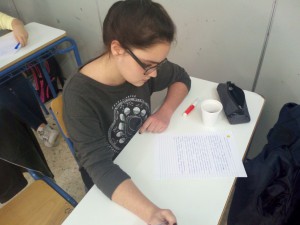

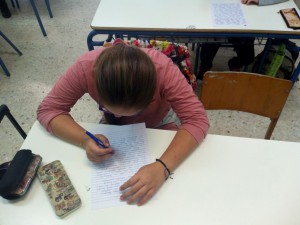
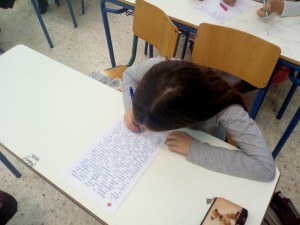
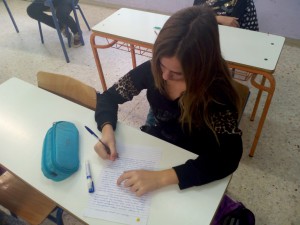
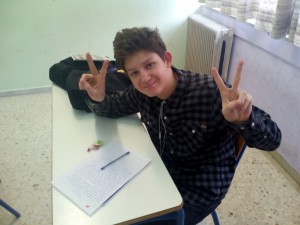
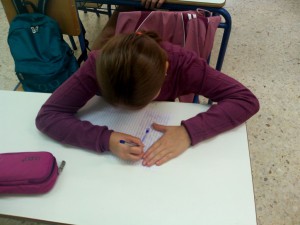
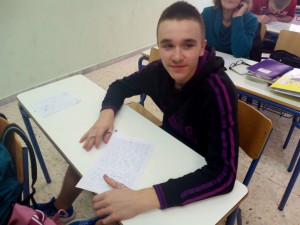
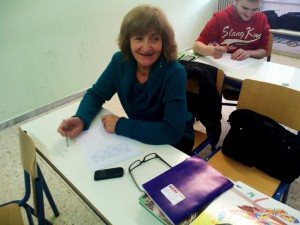
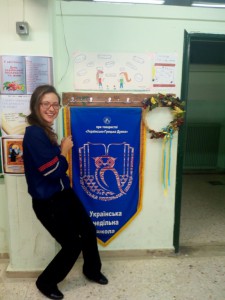
SEE UKRAINE: DOCUDAYS UA ON TOUR/ПОБАЧИТИ УКРАЇНУ ЧЕРЕЗ ДОКУМЕНТАЛЬНЕ КІНО
Дорогі друзі, запрошуємо Вас на Фестиваль українського документального фільму SeeUkraine – Побачити Україну. DOCUDAYS UA ON TOUR це акція в галузі культурної дипломатії, що реалізується Міжнародним фестивалем документального кіно про права людини Docudays UA. Цього року він з великим успіхом пройшов в багатьох країнах Європи — у Франції, Німеччині, Голландії, Італії. В Атенах фестиваль проходитиме 9, 10, 11 листопада 2016 року о 19.00 в Культурному центрі Webster Athens, розташованого на вулиці Марку Авріліу, 5, Плака (поблизу станції Монастиракі). Вхід вільний. Ваша присутність принесе нам велику радість. З повагою, Асоціація “Українсько-Грецька Думка”.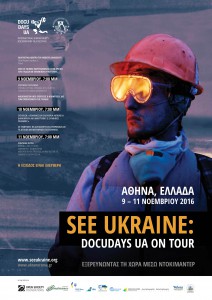
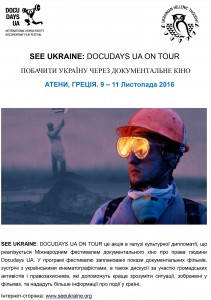
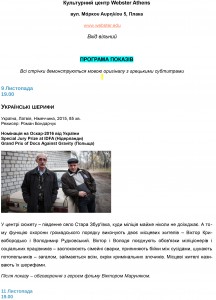
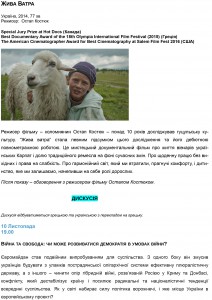
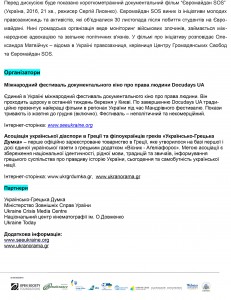
SEE UKRAINE: DOCUDAYS UA ON TOUR/ΕΞΕΡΕΥΝΩΝΤΑΣ ΤΗ ΧΩΡΑ ΜΕΣΩ ΝΤΟΚΙΜΑΝΤΕΡ
Αγαπητοί φίλοι, σας προσκαλούμε στις εκδηλώσεις του Φεστιβάλ του ουκρανικού ντοκιμαντέρ SeeUkraine. SeeUkraine - ένα έργο του Διεθνούς Φεστιβάλ Ντοκιμαντέρ για τα Ανθρώπινα Δικαιώματα Docudays UA, που ταξιδεύει στην Ευρώπη. Φέτος με μεγάλη επιτυχία έχει πραγματοποιηθεί σε πολλές χώρες της Ευρώπης - στη Γαλλία, στη Γερμανία, στην Ολλανδία, στην Ιταλία. Οι εκδηλώσεις θα λάβουν χώρα στις 9, 10 και 11 Νοεμβρίου 2016 στις 19.00 στο Πολιτιστικό Κέντρο του Webster Athens στην οδό Μάρκου Αυρηλίου 5 στην Πλάκα (Σταθμός Μετρό Μοναστηράκι). Η είσοδος στις προβολές είναι ελεύθερη. Θα είναι ιδιαίτερη τιμή να σας έχουμε κοντά μας. Με εκτίμηση, "Ουκρανο-Ελληνική Σκέψη"
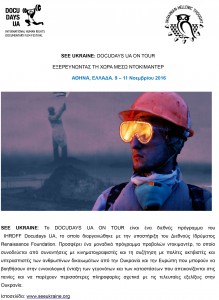
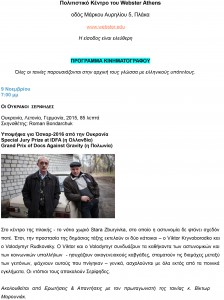
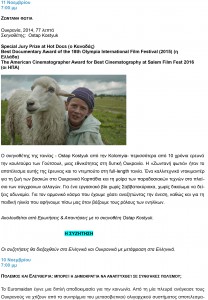
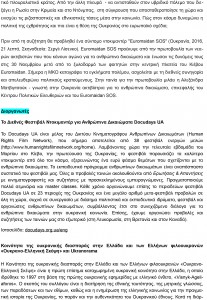
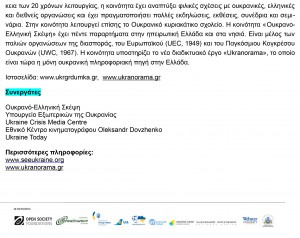
Блаженнійший Святослав: “Ваша церква ніколи вас не залишить...”
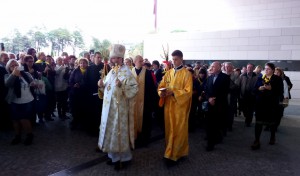
Змістовний виступ Патріарха УГКЦ на першому Форумі мігрантів УГКЦ центральної та західної Європи, який 21-23 жовтня ц. р. відбувся в португальському місті Фатіма, показав, що глава української церкви справді добре обізнаний з проблемами, турботами та потребами українських мігрантів. Він впевнено “пройшовся” по всіх больових точках, і у свій особливий спосіб дав відчути присутнім, що Українська Греко-Католицька Церква не на слові, але на ділі є поруч зі своїми людьми.
Не зважаючи на велику зайнятість через одночасне проведення 20-23 жовтня у Фатімі щорічної зустрічі ієрархів Східних Католицьких Церков Європи, голова Пасторально-Міграційного Відділу (ПМВ) Владика Йосиф (Мілян) зумів бути присутнім настільки, наскільки це було потрібним для продуктивного результату заходу, що перебував під його опікою. Цікавими та корисними були обидві сесії та всі панельні дискусії. “Духовний провід українських мігрантів в Європі: стан і перспективи”, “Проблеми, виклики і перспективи у світлі збереження християнської ідентичності”, “Суспільно-громадська діяльність українців у Європі”, “Напрямки співпраці різноманітних інституцій задля збереження ідентичності українців у Європі”, “Роль родини, Церкви, громади і держави у формуванні шкіл та позашкільних виховних закладів” - теми, які упродовж двох напружених днів обговорювали учасники форуму, що з’їхалися з України та ще 18-ти країн центральної та західної Європи. Участь у форумі була важливою, але лише однією частиною перебування українців у португальському місті Фатіма. Справді божественною виявилася Божественна Літургія в Domus Pacis спільно за участю єпископів східних Церков в Європі, Молебень до Пресвятої Богородиці, Молитва: вервиця і процесія зі свічками від каплиці об'явлення по площі Фатімського Санктуарію, Молитовні чування, Молитви, мистецько-духовна програма, Св. Тайна Покаяння. Враження та відчуття від єдності українських прочан, понад 5500 яких зїхалися до Португалії і злилися в єдиній Молитві за Україну та український народ, важко передати словами. Ще ніколи площа Фатімського Санктуарію та миряни, що прибули з різних країн на Прощу, не бачили такої кількості українських прапорів та українців разом. Завдяки ініціативі УГКЦ українцям знову вдалося привернути увагу громадськості до війни в Україні, яка продовжує тривати, хоча світ перестав про неї говорити. Тисячі голосів долучилися до Молитви під час Божественної Патріаршої Літургії, яку очолив Блаженнійший Святослав у співслужінні єпископів Східних Церков Європи. Для українців, що перебували в цей час у Фатімі, відбулося Отримання повного відпусту з нагоди Ювілею Милосердя і перехід через СВЯТІ ДВЕРІ у Санктуарії Фатіми. Від Греції участь у заходах взяли настоятель української парафії в Атенах Св. Миколая о. Орест Козак, сестра Моніка, голова Асоціації української даспори Греції та філоукраїнців греків “Українсько-Грецька Думка” Галина Маслюк та миряни парафії. Представниця Греції Галина Борик виступила з доповіддю на першій сесії на тему “Роль Церкви у плеканні духовності в умовах міграції”. В рамках форуму відбулося робоче засідання Комісії допомоги українським громадянам за кордоном, що діє при Світовому Конгресі Українців, в якому взяли участь Павло Садоха (Португалія), Олесь Городецький (Італія), Юрій Чопик (Еспанія), Галина Маслюк (Греція). Від Світового Конгресу Українців у заходах взяв участь директор українського бюро СКУ Сергій Касянчук.Галина МАСЛЮК.
Проект See Ukraine в Афінах. Перезапуск
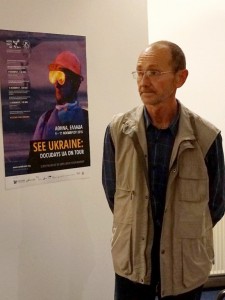 Фестиваль завершили, а я все не встигаю написати кілька слів подяки всім, хто долучився - до проведення та перегляду. Було справді дуже корисно і цікаво.
Величезна подяка Університету Webster за чудове приміщення, Посольству України, що підставили плече у скрутну хвилину, всім цікавим людям - режисерам, аналітикам, модераторам, що взяли участь у дискусіях та показах, перекладачам та технікам, глядачам, які мали багато питань і зробили дискусії та обговорення жвавими та цікавими.
Але особливу вдячність хотілося би висловити команді, яка безпосередньо, з дня в день, працювала задля найкращого результату, а саме координаторці проекту See Ukraine: Docudays UA in Tour Юлі Сердюковій, піар-менеджеру проекту Олі Бірзул, а також грецьким координаторам - Ганні Маніаті, Лесі Неделчевій, Іоанні Теліаніді.
Щиро вдячні режисеру Остапу Костюку за фільм "Жива ватра", яким ми завершили фестиваль в Афінах, та цікаву дискусію після показу. Не дивно, що стрічка завоювала стільки відзнак, там кожний кадр - унікальний. Теплою та щирою була розмова, важко було розійтися.
Приємно, що багато людей пропонували в якийсь спосіб повторити покази, на яких не змогли побувати, що ми й намагатимемось зробити. Адже всі стрічки були дуже різними і показували Україну, якої ми ніколи не бачили. Це надзвичайно цікаво! І як зазначила у своєму коментарі Юля Сердюкова, це варто робити задля тих дискусій, які слідують після показу. Саме так і зробимо.
Фестиваль завершили, а я все не встигаю написати кілька слів подяки всім, хто долучився - до проведення та перегляду. Було справді дуже корисно і цікаво.
Величезна подяка Університету Webster за чудове приміщення, Посольству України, що підставили плече у скрутну хвилину, всім цікавим людям - режисерам, аналітикам, модераторам, що взяли участь у дискусіях та показах, перекладачам та технікам, глядачам, які мали багато питань і зробили дискусії та обговорення жвавими та цікавими.
Але особливу вдячність хотілося би висловити команді, яка безпосередньо, з дня в день, працювала задля найкращого результату, а саме координаторці проекту See Ukraine: Docudays UA in Tour Юлі Сердюковій, піар-менеджеру проекту Олі Бірзул, а також грецьким координаторам - Ганні Маніаті, Лесі Неделчевій, Іоанні Теліаніді.
Щиро вдячні режисеру Остапу Костюку за фільм "Жива ватра", яким ми завершили фестиваль в Афінах, та цікаву дискусію після показу. Не дивно, що стрічка завоювала стільки відзнак, там кожний кадр - унікальний. Теплою та щирою була розмова, важко було розійтися.
Приємно, що багато людей пропонували в якийсь спосіб повторити покази, на яких не змогли побувати, що ми й намагатимемось зробити. Адже всі стрічки були дуже різними і показували Україну, якої ми ніколи не бачили. Це надзвичайно цікаво! І як зазначила у своєму коментарі Юля Сердюкова, це варто робити задля тих дискусій, які слідують після показу. Саме так і зробимо.
Проект See Ukraine в Афінах. Перезапуск
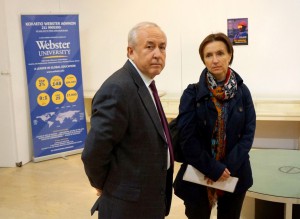
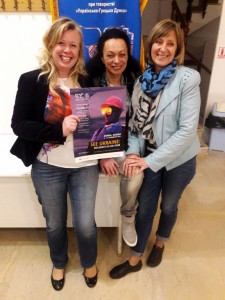
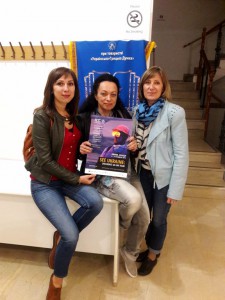
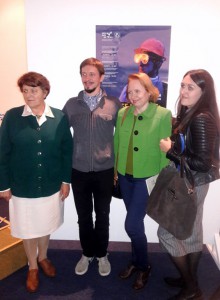
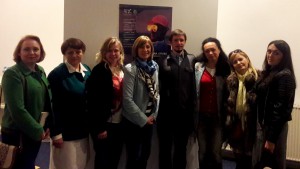
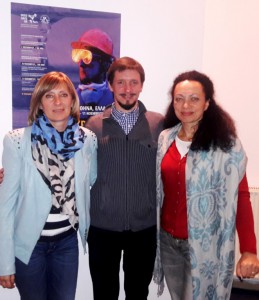
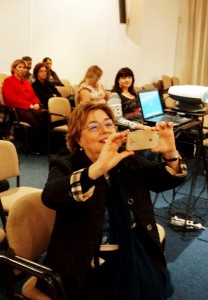
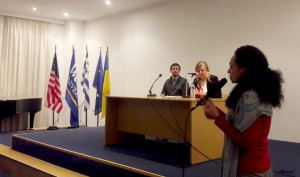
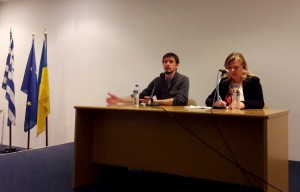
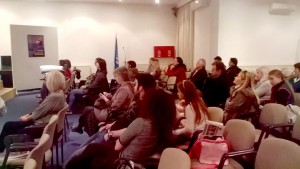
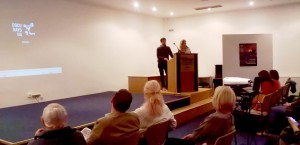
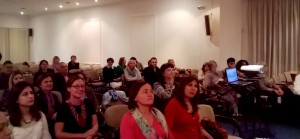
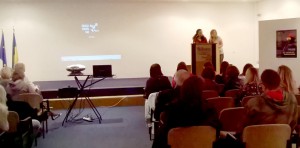
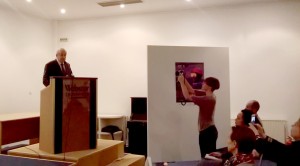
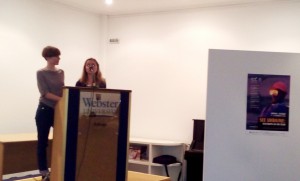
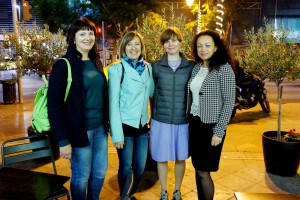
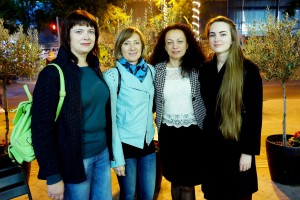
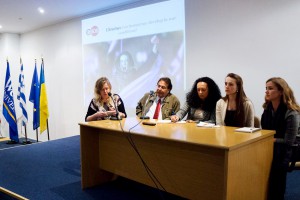
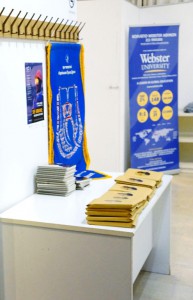
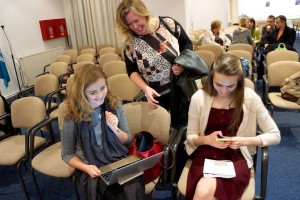
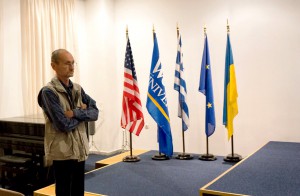
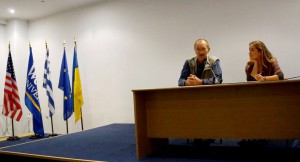
STOP PUTIN’s WAR IN UKRAINE! (Gr)
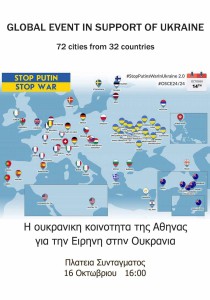 ΕΔΩ ΚΑΙ ΣΧΕΔΟΝ 3 ΧΡΟΝΙΑ, Η ΟΥΚΡΑΝΙΑ ΥΠΟΦΕΡΕΙ ΑΠΟ ΤΗΝ ΕΝΟΠΛΗ ΕΙΣΒΟΛΗ ΤΗΣ ΡΩΣΙΑΣ
- πάνω από 10 000 άνθρωποι σκοτώθηκαν
- πάνω από 22 000 άνθρωποι τραυματίστηκαν
- 3 700 000 άνθρωποι υποφέρουν
- 1 800 000 άνθρωποι αναγκάστηκαν να εγκαταλείψουν τα σπίτια τους συμπεριλαμβανομένων 228 000 παιδιών *
- 39 άνθρωποι (κυρίως Τάταροι της Κριμαίας) καταδικάστηκαν για ανυπόστατες κατηγορίες ή κρατούνται στη φυλακή
Η ΡΩΣΙΑ – ΠΑΡΑΒΑΤΗΣ ΤΟΥ ΔΙΕΘΝΟΥΣ ΔΙΚΑΙΟΥ
Η Κοινοβουλευτική Συνέλευση του Συμβουλίου της Ευρώπης (PACE) την Τετάρτη, 12 Οκτωβρίου, εξέδωσε ψήφισμα με το οποίο:
- Αποδίδει στη Ρωσία την πλήρη ευθύνη για την τήρηση ή την παραβίαση των ανθρωπίνων δικαιωμάτων στην Κριμαία και στο Ντόνμπας.
- Επιβεβαιώνει ότι η προσάρτηση της Κριμαίας από τη Ρωσία και η στρατιωτική εισβολή των ρωσικών δυνάμεων στην Ανατολική Ουκρανία παραβίασε το διεθνές δίκαιο και τις αρχές που υποστηρίζονται από το Συμβούλιο της Ευρώπης.
- Οι λεγόμενες «Λαϊκή Δημοκρατία του Ντονέτσκ» και «Λαϊκή Δημοκρατία του Λουγκάνσκ» δημιουργήθηκαν και υποστηρίζονται από τη Ρωσική Ομοσπονδία, δεν είναι νόμιμες σύμφωνα με το ουκρανικό και το διεθνές δίκαιο. Αυτό ισχύει για όλες τις «κυβερνήσεις» τους, συμπεριλαμβανομένων των «δικαστηρίων» που ιδρύθηκαν de facto από τις «αρχές».
Η Ουκρανική Διασπορά σε 32 χώρες προσελκύει για άλλη μια φορά τη διεθνή προσοχή στις φρικαλεότητες του Πούτιν.
Κάνουμε έκκληση στον ελληνικό λαό να υποστηρίξει τα αιτήματά μας.
1. Απόσυρση όλων των ρωσικών δυνάμεων από την Ουκρανία και επιστροφή πίσω στη Ρωσία όλων των ρωσικών όπλων και στρατιωτικού εξοπλισμού.
2. Ενίσχυση της αποστολής παρατηρητών του ΟΑΣΕ και επέκταση της υπηρεσίας των εκπροσώπων του έως 24 ώρες την ημέρα, 7 ημέρες την εβδομάδα. Να επιτρέψουν την πρόσβαση της αποστολής του ΟΑΣΕ στα μέρη των ουκρανό-ρωσικών συνόρων, τα οποία δεν ελέγχονται προσωρινά από την Ουκρανία. Διότι τα ρωσο-αυτονομιστικά στρατεύματα σταματούν τους βομβαρδισμούς μόνο όταν οι παρατηρητές του ΟΑΣΕ βρίσκονται στη πρώτη γραμμή.
3. Απελευθέρωση των πολιτών της Ουκρανίας, οι οποίοι κρατούνται στη φυλακή τόσο στη Ρωσία, όσο και στην Κριμαία λόγω πολιτικά αιτιολογημένων, χαλκευμένων κατηγοριών.
#StopPutinsWarInUkraine #LookForErvin #FreeSuschenko #FreeSentsov follow site www.ukranorama.gr
* Στοιχεία από τον ΟΗΕ για την περίοδο από Απρίλιο 2014 έως την 31η Ιουλίου 2016
ΕΔΩ ΚΑΙ ΣΧΕΔΟΝ 3 ΧΡΟΝΙΑ, Η ΟΥΚΡΑΝΙΑ ΥΠΟΦΕΡΕΙ ΑΠΟ ΤΗΝ ΕΝΟΠΛΗ ΕΙΣΒΟΛΗ ΤΗΣ ΡΩΣΙΑΣ
- πάνω από 10 000 άνθρωποι σκοτώθηκαν
- πάνω από 22 000 άνθρωποι τραυματίστηκαν
- 3 700 000 άνθρωποι υποφέρουν
- 1 800 000 άνθρωποι αναγκάστηκαν να εγκαταλείψουν τα σπίτια τους συμπεριλαμβανομένων 228 000 παιδιών *
- 39 άνθρωποι (κυρίως Τάταροι της Κριμαίας) καταδικάστηκαν για ανυπόστατες κατηγορίες ή κρατούνται στη φυλακή
Η ΡΩΣΙΑ – ΠΑΡΑΒΑΤΗΣ ΤΟΥ ΔΙΕΘΝΟΥΣ ΔΙΚΑΙΟΥ
Η Κοινοβουλευτική Συνέλευση του Συμβουλίου της Ευρώπης (PACE) την Τετάρτη, 12 Οκτωβρίου, εξέδωσε ψήφισμα με το οποίο:
- Αποδίδει στη Ρωσία την πλήρη ευθύνη για την τήρηση ή την παραβίαση των ανθρωπίνων δικαιωμάτων στην Κριμαία και στο Ντόνμπας.
- Επιβεβαιώνει ότι η προσάρτηση της Κριμαίας από τη Ρωσία και η στρατιωτική εισβολή των ρωσικών δυνάμεων στην Ανατολική Ουκρανία παραβίασε το διεθνές δίκαιο και τις αρχές που υποστηρίζονται από το Συμβούλιο της Ευρώπης.
- Οι λεγόμενες «Λαϊκή Δημοκρατία του Ντονέτσκ» και «Λαϊκή Δημοκρατία του Λουγκάνσκ» δημιουργήθηκαν και υποστηρίζονται από τη Ρωσική Ομοσπονδία, δεν είναι νόμιμες σύμφωνα με το ουκρανικό και το διεθνές δίκαιο. Αυτό ισχύει για όλες τις «κυβερνήσεις» τους, συμπεριλαμβανομένων των «δικαστηρίων» που ιδρύθηκαν de facto από τις «αρχές».
Η Ουκρανική Διασπορά σε 32 χώρες προσελκύει για άλλη μια φορά τη διεθνή προσοχή στις φρικαλεότητες του Πούτιν.
Κάνουμε έκκληση στον ελληνικό λαό να υποστηρίξει τα αιτήματά μας.
1. Απόσυρση όλων των ρωσικών δυνάμεων από την Ουκρανία και επιστροφή πίσω στη Ρωσία όλων των ρωσικών όπλων και στρατιωτικού εξοπλισμού.
2. Ενίσχυση της αποστολής παρατηρητών του ΟΑΣΕ και επέκταση της υπηρεσίας των εκπροσώπων του έως 24 ώρες την ημέρα, 7 ημέρες την εβδομάδα. Να επιτρέψουν την πρόσβαση της αποστολής του ΟΑΣΕ στα μέρη των ουκρανό-ρωσικών συνόρων, τα οποία δεν ελέγχονται προσωρινά από την Ουκρανία. Διότι τα ρωσο-αυτονομιστικά στρατεύματα σταματούν τους βομβαρδισμούς μόνο όταν οι παρατηρητές του ΟΑΣΕ βρίσκονται στη πρώτη γραμμή.
3. Απελευθέρωση των πολιτών της Ουκρανίας, οι οποίοι κρατούνται στη φυλακή τόσο στη Ρωσία, όσο και στην Κριμαία λόγω πολιτικά αιτιολογημένων, χαλκευμένων κατηγοριών.
#StopPutinsWarInUkraine #LookForErvin #FreeSuschenko #FreeSentsov follow site www.ukranorama.gr
* Στοιχεία από τον ΟΗΕ για την περίοδο από Απρίλιο 2014 έως την 31η Ιουλίου 2016STOP PUTIN’s WAR IN UKRAINE! (Ua)
 STOP PUTINS WAR IN UKRAINE!
STOP PUTINS WAR IN UKRAINE!
- ВЖЕ МАЙЖЕ ТРИ РОКИ УКРАЇНА ПОТЕРПАЄ ВІД ВІЙСЬКОВОЇ АГРЕСІЇ РОСІЇ понад 10 000 осіб вбито понад 22 000 осіб поранено 3 700 000 осіб постраждалі 1 800 000 осіб вимушено покинули свої домівки, в тому числі 228 000 дітей * 39 осіб (переважно кримські татари) засуджені за фальсифікованими звинуваченнями або утримуються у в’язницях.
- РОСІЯ – ПОРУШНИК МІЖНАРОДНОГО ПРАВА Парламентська асамблея Ради Європи (ПАРЄ) у середу, 12 жовтня, прийняла резолюцію, в якій: - поклала на Росію повну відповідальність за дотримання або порушення прав людини як в Криму, так і на Донбасі. - підтверджує, що анексія Криму Російською Федерацією та військове вторгнення російських збройних сил на сході України порушують міжнародне право та принципи, підтримані Радою Європи. - «ДНР» та «ЛНР», створені, підтримувані та ефективно контрольовані Російською Федерацію, не є легітимними відповідно до українського чи міжнародного права. Це стосується всіх їхніх «органів влади», включаючи «суди», встановлені владою де-факто.
- Українська Діаспора в 32 країнах світу знову привертає увагу міжнародного співтовариства до безчинств Путіна
- Звертаємося до грецького народу підтримати наші вимоги. 1. Вивести з території України всі російські окупаційні війська, а також повернути назад в Росію всю зброю та воєнну техніку. 2. Посилити (збільшити) спостережну місію ОБСЄ і подовжити її роботу до 24 годин на добу 7 днів в тиждень, та допустити місію ОБСЄ до частини українсько-російського кордону який Україна тимчасово не контролює - адже російсько-сепаратистські війська припиняють атаки тільки тоді, коли спостерігачі ОБСЄ присутні на фронті. 3. Звільнити громадян України, які незаконно утримуються під арештом-як на території Росії, так і в Криму-за політично мотивованими і сфабрикованими звинуваченнями.www.ukranorama.gr #StopPutinsWarInUkraine #LookForErvin* Дані ООН за період з квітня 2014 року до 31 липня 2016
